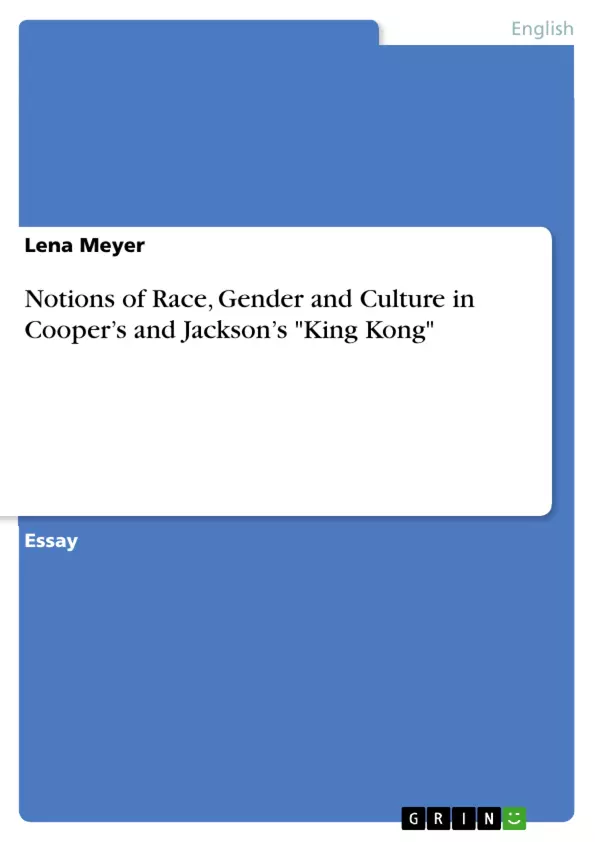This paper deals with the socio-cultural parameters of representation in movies, focussing on a comparative reading of Cooper's (1933) and Jackson's (2005) "King Kong"-movies.
The academic consideration of movies and their significance regarding the creation and shaping of discourse is a relatively new, yet fruitful approach to socio-cultural studies (c.f. Erb 1998: 13f. a. Benshoff & Griffin 2004: 3). Like other cultural items, movies reflect the norms and realities of the environment they are produced in and, thus, feature statements about what their respective culture of origin considers to be ‘normal’ – on both overt and covert, or, conscious and unconscious levels (c.f. Vogler 1978: 109). The presentation of these notions in Hollywood films offers “keen insights into the ways that different groups of American people have been treated (and continue to be treated)” (Benshoff & Griffin 2004: 3). It is therefore important to note that the, albeit fictive, representations of people on screen are also capable of influencing their perception in real life (c.f. ibid.).
The analysis of genre movies appears to be especially suited for socio-cultural considerations, as these movies not only provide comparable narrative structures, but also feature recurring tropes (c.f. Stymeist 2009: 395f. a. Benshoff & Griffin 2004: 30f). Furthermore, the extent of their success and endurance mirrors their respective capability of representing and mediating discourse, as well as contextualizing it with regard to current social realities (c.f. ibid.).
Taking these parameters into account, it can be argued that the horror genre is particularly promising in this respect, as it usually features a monster which counters social norms concerning notions such as race, class and gender (c.f. ibid.). In that, the monster embodies a society’s fears and is sometimes even regarded as a perversion threatening the status quo which, “in classic Hollywood horror films [...], is conventionally represented by middle-to-upper-class, white, heterosexual couples and patriarchal institutions” (Benshoff & Griffin 2004: 31).
Merian Cooper’s King Kong (1933, c.f. Internet Movie Database, IMDb) might arguably be the most striking example that comes to mind when evaluating the socio-cultural impact of horror movies, especially when focusing on the representation of race, gender and culture (c.f. Cowlishaw 2006: 1714, Stymeist 2009: 396f. a. Erb 1998: 13-15). [...]
Inhaltsverzeichnis (Table of Contents)
- Introduction
- 'Black Buck' meets 'White Goddess' - Race and Sexuality in King Kong
- Spotting the Victim – Gender in King Kong
- Nature's Revenge on Industry - Culture in King Kong
Zielsetzung und Themenschwerpunkte (Objectives and Key Themes)
This paper presents a comparative and historically contextualized reading of the two King Kong films, focusing on the delineation of norms regarding race, gender, and culture. It aims to analyze how these discursive notions are represented in both versions, considering any significant differences between the two films.
- Race and Sexuality in King Kong
- Gender Representation in King Kong
- Cultural Significance in King Kong
- The Role of Primitivism and Othering in King Kong
- The Impact of Genre Conventions on King Kong
Zusammenfassung der Kapitel (Chapter Summaries)
- Introduction: This chapter sets the stage for the analysis by discussing the significance of movies in shaping socio-cultural discourse, focusing on the horror genre and the potential of its monsters to embody societal fears. It introduces the two King Kong films, highlighting their cultural impact and the need for a contextualized reading.
- 'Black Buck' meets 'White Goddess' - Race and Sexuality in King Kong: This chapter explores the racial and sexual implications of the giant ape's portrayal in both King Kong films. It examines the concepts of Othering and Primitivism, arguing that King Kong's representation draws on racist tropes and fantasies of miscegenation. The chapter analyzes the contrasting roles of the "Black Buck" and the "White Goddess" in the narrative, highlighting the association of whiteness with purity and sovereignty.
Schlüsselwörter (Keywords)
This paper focuses on the themes of race, gender, and culture in the context of genre movies, particularly the horror and monster genre. Key terms and concepts include: Othering, Primitivism, miscegenation, Black Buck, White Goddess, and the impact of genre conventions on the representation of these themes.
- Quote paper
- Lena Meyer (Author), 2015, Notions of Race, Gender and Culture in Cooper’s and Jackson’s "King Kong", Munich, GRIN Verlag, https://www.grin.com/document/299334



